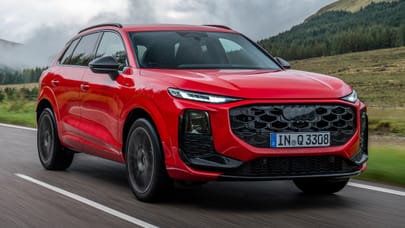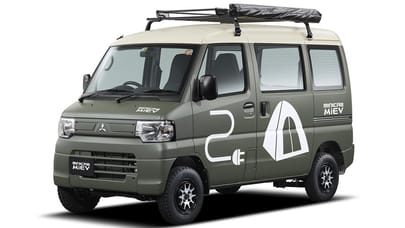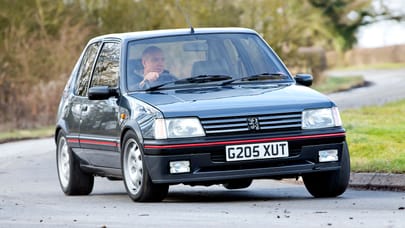
On the road in Ford's classic RS cars
The new Focus RS is just the latest in a long line of fast Fords. Here's the family tree

1974 Ford MkI Escort Mexico

Why It Matters
Rallye Sport. That’s what Ford’s RS moniker stands for, and the Escort wears the letters more proudly – with greater credibility – than most, because it’s arguably the greatest off-road racing car of them all. The MkI overspills with so much pedigree, it couldn’t be contained in the RS1600 model, so Ford created this – the Mexico – to pay homage to Hannu Mikkola’s victory in the gruelling 1970 London to Mexico World Cup Rally.
That said, the MkI Escort Mexico isa bit of a fibber. For one thing, the iconic colour daubed over it is called Sebring Red, when it’s clearly as orange as a tanning sponge. And really, it was never properly badged as an RS either, despite the subtle lettering lodged in the 13in alloys’ hubcaps. Below the MkI Escort RS1600 in the range, the Mexico was a lesser performance model. This car’s modern ancestor is really an appropriately orange Focus ST – not the ultimate performance version, but a nicely rounded, decently entertaining halfway house. But what we have here is really a genesis point for Ford’s blue-collar performance cars.
Photography: Mark Riccioni
This feature was originally published in the March 2016 issue of Top Gear magazine.
Advertisement - Page continues below
What It’s Like To Drive
Not fast. The 1600cc Kent engine is a hardy little workhorse, but it’s no revvy little fireball, developing just 87bhp. You’ll be doing a lot of gearchanges then, which is excellent news, because the dainty four-speed gearbox is a delicate joy to operate, and there is synchromesh too, so it’s not the graunch-fest guessing game you might expect from a car lighting 42 candles on its next birthday cake.
Predictably, everything is about taking your time – the gearshifts, the rather wooden braking performance, even measuring out the throttle’s mechanical fuel injection. But the Mexico helpsyou take things slowly, with its squidgy body control and oh-so-progressive grip breakaway. Even with less power than a boggo Fiesta, you can have the tail mildly out on a mini-roundabout in the Mexico, threading the beautifully slim three-spoke ‘RS’ steering wheel between your hands, gurning like Gene Hunt on the lookout for a pile of cardboard boxes to pinball into. It’s a tonic.

How To Buy One
First, you’ve got to find one that hasn’t been donated into organs or had its bodyshell sacrificed at the altar of grass-roots rallying. The Escort’s stellar period competition pedigree has dented the number left for road japes. After that,the next big gripe, as with most Seventies cars, is rust. Look especially around the suspension top mounts (luckily these are reinforced on the Mexico), rear wings and the plenum drain tube under the bonnet, which can get clogged with leaves and set the tinworm loose in the engine bay. Tired fabric seats are a wear point, and few cars have this example’s ‘custom pack’ featuring Recaro chairs and walnut fascia. Budget around £20,000 for a well-worn rally car, and well over £30k if you fancy a roadworthy one. Regret selling yours?
Advertisement - Page continues below1985 Ford Sierra RS Cosworth

Why It Matters
Other than the fact it drags around a bloody great whale-tail spoiler? Well, it’s a proper homologation special, continuing RS’s fine form for motorsport pedigree, though this time as a Group A touring car refugee rather than skidding about forests and desert stages. The Sierra did tackle the rough stuff, but rear-wheel drive meant it was always happier on tarmac stages, or, better yet, a proper racetrack. Only supposed to be produced to meet the FIA’s 5,000 homolgation quota, Cosworth insisted that if it were to be on board, Ford would get 15,000 engines whether it liked it or not, and they’d all comfortably see off the manufacturer’s request for 180bhp. Fighting talk. So, astoundingly, 15,000 engines were contracted, developing in excess of 204bhp. It was so powerful, Ford had to draft in the manual gearbox from the Mustang – complete with bespoke reinforcement to cope with the four-pot Sierra’s zestier response – to deal with the onslaught. The development team, alarmed how much lift the regular ‘jellymould’ Sierra body produced at speed, meanwhile, demanded the whale-tail appendage.

What It’s Like To Drive
The driving position is terrific, first off – low, with cradling bolsters and an ideally situated and shaped wheel jutting toward your chest. The car feels soft initially, with plenty of play in the steering and a suppleness that’s quite endearing for something that looks so aggressive. And as you’d expect, the Mustang-sourced gearbox could do with a two-handed grab when cold. The brakes couldn’t be more different – precise, powerful and brimming with feel. And they need to be, because once the turbo gets out of bed and onto the treadmill, the thrust of the Sierra is bonkers. You’re sat in a ghetto blaster, surrounded by graphic equaliser buttons, and all of a sudden an engine detonates in the middle distance and with huge traction you’re catapulted into the next county. Completely addictive.

How To Buy One
Look out for cracked dashboard tops where the summer sun has warped brittle plastic. Plenty have been modded, or crashed, or both, on account of the unforgiving turbo’s devilment. Another known trouble spot is failing injectors and the engine’s fuel regulator. Prices are climbing well beyond £30,000 now, with RS500 editions double that… ouch.
1994 Ford Escort RS Cosworth

Why It Matters
The Escort RS Cosworth was the first Ford to win the Monte Carlo rally for four decades, but it owes a hefty debt of thanks to the Sierra for that wreath and champagne. Ford used the same mechanical package as the later 4x4 Sierra Sapphire to underpin the Escort Cossie, with 227bhp being transmitted to all four wheels via a five-speed manual gearbox. The whale-tail was back, wilder than ever, and created one of the Nineties most recognisable vehicular silhouettes. It’s something of a cultural icon, for a certain wide-boy image, an unfortunate target for joyriders, and now as a platform for tuners to pull double or even triple the factory power output from the Garrett turbocharged motor. Later cars switched to a smaller, freer-spinning blower in an effort to reduce the car’s gaping chasm of turbo lag.
Advertisement - Page continues below
What It’s Like To Drive
Perhaps the car here that’s closest to the “don’t meet your heroes” cliche, if only for the fact that a car which looks so outrageous is something of a one-trick pony when being driven on the road. Like the Sierra, it delivers a rush of torque when the exhaust gases finally get that turbine spinning, but with extra mass to shift and an all-wheel-drive system bleeding power away, the hit isn’t as sonic, and the gearshift is of a longer, slacker throw, so the car lunges down the road in a staccato series of bursts, without ever really getting into a stride. You can clearly note where modern buyers’ needs have been pandered to between the Eighties and Nineties car – the steering is lighter and quicker, and the brakes offer massive servo assistance. The Escort Cossie is now in that awkward area of not being quite old enough to feel totally alien, but by no means comparable to a modern performance hatch. You can see why buyers get the RS tuning itch….

How To Buy One
Again, it’s finding a clean, untouched one that’s the first task, but once you’re foraging it’s a pleasant surprise to see prices are still within the low twenty thousands, well below the related Sierra. Again, the injectors are a black spot, so make sure the car settles into a clear and consistent idle when started. It’s also worth a comprehensive history check to be sure your prospective Cossie has never been rounded up by the law.
Advertisement - Page continues below2002 Ford Focus RS MkI

Why It Matters
Because it’s arguably the most handsome hot hatchback of them all? Frankly, the Focus RS needed looks on its side, because the raw data suggested a retrograde step from the old Escort Cossie. Front-, not all-wheel drive was employed, despite the butch bodykit’s obvious WRC car inspiration. The 2.0-litre turbo engine made 212bhp – a healthy lump for hot hatches in the early 2000s, but 15bhp down on its immediate RS predecessor. The Focus RS answered back with what remains its most controversial, divisive component – no, not the blue-black crime against steering wheels – but the torque-sensing front differential. What with the likes of the Megane RenaultSport and Honda Civic Type-R successfully pushing upwards of 275bhp, even 300bhp out the front axle these days, it’s difficult to get your head around just what a datum point it was when Ford essentially put a locking diff in the front of a fast Focus and sent it into battle against the all-wheel-drive Golf R32 and Subaru Impreza. The media feedback of the time was more polarised than a Question Time audience. Owners quickly split into tribes of evangelists and, uh, ex-owners.

What It’s Like To Drive
Frenetic and memorable. In fact, it’s not dissimilar to the current Honda Civic Type-R. There’s a satisfying alloy-topped gearchange, strong, confidence-inspiring brakes, and the whole experience is dominated by managing that front axle. Yes, it torque-steers when the barrel-chested turbo comes fully online at around 3,500rpm, but it’s not the unmanageable, fighty mess the car’s detractors want history to remember it as. It’s way faster point-to-point than the old Escort Cossie, thanks to a less narcoleptic turbo and sweeter gearing. OK, it’ll follow cambers, which can be mildly unnerving if the boost arrives just as the car’s nose has decided to follow a channel towards the undergrowth, and the ride has been described as being on the uncompromising side of firm. But neither of these makes the Focus difficult to drive. It’s utterly absorbing, and demands a bit more concentration, which is a familiar refrain through this lot. You really could daily-drive it, so long as the baffling high-set seat doesn’t wind you up.

How To Buy One
There are two main things to watch out for when sourcing yourself a Focus RS. The first is, like its predecessors, working out if you want to put up with someone else’s fiddling. Plenty of the 4,501 cars built have been subjected to various degrees of modification, from simple lowering and exhaust jobs to 400 or even 500bhp conversions. And this heralds the u-word appearing in the classifieds: “unmolested”. Standard-spec RS MkIs are now back over five figures in price, and low-mileage ones are climbing. Secondly, the wayward handling is massively sensitive to set up, with tyre wear and geometry playing a huge role in whether you get a good or evil RS. A car that’s been laser-aligned by its owner will be worth paying extra for.







